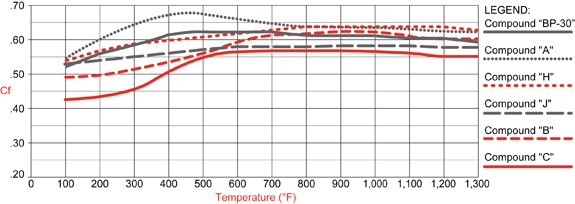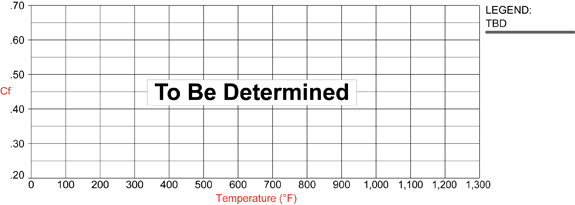|
|
|
|
|
|
| Compound Temperature Range & Torque Values |

PolyMatrix A Compound Temperature Range & Torque Values
|
| Temperature range and overall friction value are the primary considerations for pad selection. The pads must be capable of maintaining the proper amount of friction for stopping power within the temperatures that will be realized on the track during the event. Then, overall wear rate must be considered. For most asphalt and road race applications, compounds in the high temperature ranges over 1000°F range are usually necessary. Dirt track, drag race, and street performance applications usually operate at temperatures between 500° and 1000°F. Keep in mind that these are general ranges, and not absolute values. Many factors and unforeseen influences can affect brake temperatures. The best indicator for pad selection will always be on track performance. If pad fade (friction loss) due to overheating occurs, then improved cooling, a heavier rotor, or a higher temperature range pad may all become necessary. |
|
BP-40

BP-40
|

Compound Data Sheet |
Use & Caution:
- A very high friction pad with aggressive initial response.
- Immediate low tempeature response.
- Low wear rate.
- Racing Only; Not For Street Use!
|
Application:
- Race ONLY compound used in severe duty oval, road course, and off-road series that require an aggressive response and durability in the highest temperature ranges.
- Lightweight sprints and club sport racers using steel plate rotors that require fast response at low temperatures with resistance to fade during periodic or temporary high temperature spikes.
"
|
Characteristics:
- Improved friction formula for heavy braking asphalt ovals, extreme braking on dirt, and all types of off-road and road course applications.
- Predictable and linear response with excellent modulation on iron and titanium rotors.
- Long wear rates with iron and steel rotors.
- High torque on Titanium rotors.
- Very high heat fade resistance.
|
| |
| Compound Temperature Range & Torque Values |

BP-40 Compound Temperature Range & Torque Values
|
| Temperature range and overall friction value are the primary considerations for pad selection. The pads must be capable of maintaining the proper amount of friction for stopping power within the temperatures that will be realized on the track during the event. Then, overall wear rate must be considered. For most asphalt and road race applications, compounds in the high temperature ranges over 1000°F range are usually necessary. Dirt track, drag race, and street performance applications usually operate at temperatures between 500° and 1000°F. Keep in mind that these are general ranges, and not absolute values. Many factors and unforeseen influences can affect brake temperatures. The best indicator for pad selection will always be on track performance. If pad fade (friction loss) due to overheating occurs, then improved cooling, a heavier rotor, or a higher temperature range pad may all become necessary. |
|
PolyMatrix H

PolyMatrix H
|

Compound Data Sheet |
Use & Caution:
- High friction, smooth intitial response.
- Steady rise in friction as temperature increases.
- Low wear rate
- Racing Only; Not For Street Use!
|
Application:
- Race ONLY compound for long wear in sustained high heat on hard braking ovals and road courses.
- Trail braking or "touch and go" tracks.
- Endurance applications.
|
Characteristics:
- Smooth initial engagement with a linear increase as heat and pressure rise.
- Severe duty use for road courses and hard braking pavement/dirt ovals.
- Predictable response with excellent modulation at all temperatures.
- Long wear rate for durability in sustained high heat.
- Compatible with all iron and steel rotors.
- High torque on SS rotors.
|
| |
| Compound Temperature Range & Torque Values |

PolyMatrix H Compound Temperature Range & Torque Values
|
| Temperature range and overall friction value are the primary considerations for pad selection. The pads must be capable of maintaining the proper amount of friction for stopping power within the temperatures that will be realized on the track during the event. Then, overall wear rate must be considered. For most asphalt and road race applications, compounds in the high temperature ranges over 1000°F range are usually necessary. Dirt track, drag race, and street performance applications usually operate at temperatures between 500° and 1000°F. Keep in mind that these are general ranges, and not absolute values. Many factors and unforeseen influences can affect brake temperatures. The best indicator for pad selection will always be on track performance. If pad fade (friction loss) due to overheating occurs, then improved cooling, a heavier rotor, or a higher temperature range pad may all become necessary. |
|
BP-30

BP-30
|

Compound Data Sheet |
Use & Caution:
- High friction, smooth intitial response.
- Steady rise in friction as temperature increases.
- Low wear rate
- Racing Only; Not For Street Use!
|
Application:
- Race ONLY compound is a value priced, proven workhorse for most weekly category asphalt late models, sprints, modifieds, and sportsman divisions.
- Hard braking dirt late models, DIRT modifieds, and rear inboard sprint brakes with vented iron or steel rotors.
- SCCA club racers, rally, and auto-cross.
- High MPH drag cars if high end fade occurs with lower temperature pads.
|
Characteristics:
- Newest racing pad from Wilwood
- Medium-high friction compound with good cold response.
- Smooth, predictable engagement with excellent control over a wide range of applications.
- Long wearing pad in the middle temperature ranges with moderate wear in sustained high heat conditions.
- Easily bedded without abrasion on new iron or steel rotors.
|
| |
| Compound Temperature Range & Torque Values |

BP-30 Compound Temperature Range & Torque Values
|
| Temperature range and overall friction value are the primary considerations for pad selection. The pads must be capable of maintaining the proper amount of friction for stopping power within the temperatures that will be realized on the track during the event. Then, overall wear rate must be considered. For most asphalt and road race applications, compounds in the high temperature ranges over 1000°F range are usually necessary. Dirt track, drag race, and street performance applications usually operate at temperatures between 500° and 1000°F. Keep in mind that these are general ranges, and not absolute values. Many factors and unforeseen influences can affect brake temperatures. The best indicator for pad selection will always be on track performance. If pad fade (friction loss) due to overheating occurs, then improved cooling, a heavier rotor, or a higher temperature range pad may all become necessary. |
|
PolyMatrix B

PolyMatrix B
|

Compound Data Sheet |
Use & Caution:
- Medium-high friction, good cold response
- Gently rising torque curve, predictable engagemnet
- Low wear rate at medium temperatures, increasing to moderate at high temperature.
- Racing Only; Not For Street Use!
|
Application:
- Race ONLY compound is a value priced, proven workhorse for most weekly category asphalt late models, sprints, modifieds, and sportsman divisions.
- Hard braking dirt late models, DIRT modifieds, and rear inboard sprint brakes with vented iron or steel rotors.
- SCCA club racers, rally, and auto-cross.
- High MPH drag cars if high end fade occurs with lower temperature pads.
|
Characteristics:
- Traditional favorite for asphalt LM's, modifieds, and sprints.
- Modifieds, late models, and other hard braking dirt applications.
- Intermediate weight road course, auto-cross, rally.
- Beds easily and fully compatible with all iron and steel.
|
| |
| Compound Temperature Range & Torque Values |

PolyMatrix B Compound Temperature Range & Torque Values
|
|








